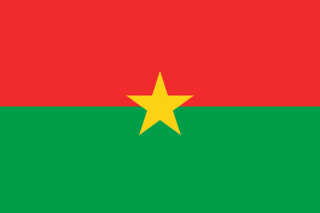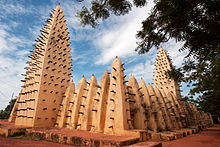
Transport in Burkina Faso consists primarily of road, air and rail transportation. The World Bank classified country's transportation as underdeveloped but noted that Burkina Faso is a natural geographic transportation hub for West Africa.

Ouagadougou or Wagadugu is the capital of Burkina Faso, and the administrative, communications, cultural and economic centre of the nation. It is also the country's largest city, with a population of 2,415,266 in 2019. The city's name is often shortened to Ouaga. The inhabitants are called ouagalais. The spelling of the name Ouagadougou is derived from the French orthography common in former French African colonies.

Bobo-Dioulasso is a city in Burkina Faso with a population of 1,129,000 ; it is the second-largest city in the country, after Ouagadougou, Burkina Faso's capital. The name means "home of the Bobo-Dioula".

Sudano-Sahelian architecture refers to a range of similar indigenous architectural styles common to the African peoples of the Sahel and Sudanian grassland (geographical) regions of West Africa, south of the Sahara, but north of the fertile forest regions of the coast.
The Gwiriko Kingdom, also known as Gouiriko was a kingdom in the 18th and 19th centuries in what is now part of present-day Burkina Faso around the watershed of the River Banifin. It was founded by Famagah Ouattara (Wattara) and lasted until French occupation in 1897. Its chief city was Bobo-Dioulasso.

Sikasso is a city in the south of Mali and the capital of the Sikasso Cercle and the Sikasso Region. It is Mali's second largest city with 225,753 residents in the 2009 census.

Balé is one of the 45 provinces of Burkina Faso, located in its Boucle du Mouhoun Region with Boromo as capital. Its area is 4,596 km2 (1,775 sq mi), and had a population of 297,367 in 2019. The province is known for its Deux Balé Forest, populated by savannah elephant herds. Boromo, the provincial capital, is located on the main road from Ouagadougou to Bobo-Dioulasso. In June 2007, the Canadian mining company, Semafo, open the third gold mine in the country in Mana in the province, with an investment of about $116 million.

Tieba Traoré was the fourth king of the Kénédougou Kingdom, reigning from 1877 until his death in 1893.

The Kénédougou Kingdom,, was a pre-colonial West African state established in the southeastern portion of present-day Mali, as well as parts of northern Côte d'Ivoire and western Burkina Faso.

Islam in Burkina Faso has a long and varied history. According to the 2010 census, the population of the country was 63.2% Muslim. The 2019 census notes that 63.8% of the population are Muslim

The Catholic Church in Burkina Faso is part of the worldwide Catholic Church, under the spiritual leadership of the Pope in Rome. According to the CIA Factbook, in 2018, 17% of the population are members of the Catholic Church.
Articles related to Burkina Faso include:

The Trans-Sahelian Highway or TAH 5 is a transnational highway project to pave, improve and ease border formalities on a highway route through the southern fringes of the Sahel region in West Africa between Dakar, Senegal in the west and Ndjamena, Chad, in the east. Alternative names for the highway are the Dakar-Ndjamena Highway or Ndjamena-Dakar Highway and it is Trans-African Highway 5 in the Trans-African Highway network.

Football is the most popular sport in Burkina Faso. And the national association can look back on recent developments with a great deal of pride. Reaching the semi-finals of the African Cup of Nations on home soil in 1998, reaching the knockout stage for their first FIFA World Youth Championship in 2003, and appearances at two final competitions of the CAF U-17 Cup, as well as third place at the FIFA U-17 World Championship in Trinidad and Tobago in 2001 are the country's outstanding achievements at international level. The nations most famous players include Kassoum Ouegraogo, nicknamed Zico, who had his most successful seasons with Espérance de Tunis before ending his career in Germany, Siaka Ouattara, who spent his entire career with Mulhouse in France, and Moumouni Dagano, who was voted best African player in Belgium in 2001, when he played for the Belgian side Genk. He later went on to play for the French side Guingamp before transferring to another French team, FC Sochaux in 2005. Burkina Faso received an unexpected free pass into the group stage of the 2006 FIFA World Cup qualification process, when their opening round contestant, the Central African Republic, withdrew from the competition. This gave the West Africans, who were at that stage ranked 14th on the continent, the certainty that their name would be in the hat when the Preliminary Draw for the 2006 FIFA World Cup in Germany was made. They got off to a flying start, beating Ghana 1-0 in their opening match and laying down a marker for their Group 2 adversaries South Africa, Cape Verde Islands, Congo DR and Uganda. The victory train began to come off the rails with two defeats to Cape Verde, and with a record of two wins and three losses, Burkina Faso were up against it at the half-way stage. Frenchman Bernard Simondi took over the coaching reins from Ivica Todorov and made the team harder to beat at home, even recording wins over South Africa and Congo DR, but in the end it was not quite enough, and the likes of Abdoulaye Cisse, Moumouni Dagano, and Wilfred Sanou went no further in the competition.
The 2011 Burkina Faso protests were a series of popular protests in Burkina Faso.
Le Balai Citoyen, is a political grassroots movement in Burkina Faso, which was part of the opposition against President Blaise Compaoré. It was co-founded by two musicians, reggae artist Sams’K Le Jah and rapper Serge Bambara ('Smockey') in the Summer of 2013. They organized several protests in early 2014, for example hosting a joint rally with the newly formed Movement of People for Progress, filling a 35,000-capacity sports stadium to its rafters.

Ahmadiyya is an Islamic branch in Burkina Faso under the leadership of the caliph in London. Although the Community was established and officially recognized as an Islamic community in 1986, there were small communities of Ahmadi Muslims in existence several decades prior to its establishment.
Kodeni Solar Power Station, is a 38 MW (51,000 hp) solar power plant in Burkina Faso. The solar farm was development by the French IPP, Africa Ren, with funding from European financial institutions, led by FMO Entrepreneurial Development Bank of the Netherlands. Société Nationale d'électricité du Burkina Faso (SONABEL), the state-owned electricity utility company signed a 25-year power purchase agreement (PPA), with Koden Solar SASU, the special purpose vehicle company established by the owners to own, develop, operate and maintain the solar farm. The power station reached commercial commissioning in December 2023.

Martin Zongo is a Burkinabé cultural figure, professor, cultural administrator, and member of the economic and social council of Burkina Faso. He is the administrator of the Carrefour international de théâtre de Ouagadougou (CITO).

The Mosques of West Africa are mosques located in the region of West Africa that encompasses Benin, Burkina Faso, Cape Verde, The Gambia, Ghana, Guinea, Guinea-Bissau, Ivory Coast, Liberia, Mali, Mauritania, Niger, Nigeria, Senegal, Sierra Leone, and Togo. The architecture of these mosques differ from mosques around the world as they have unique building practices and cultural roles. Islam in Africa spread to the region around the 10th century and established the first written language of West Africa. The spread of Islam into West Africa had impacted scholarship, commerce, and utilized indigenous traditions unique to the area. Sudanese Jihads had formulated their own branch of Islam, establishing powerful Islamic states. Islam is one of the major religions present in Africa, with mosques being architectural spaces used for Muslim worship.
















